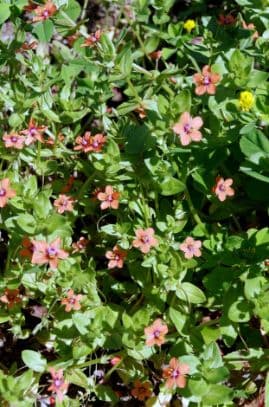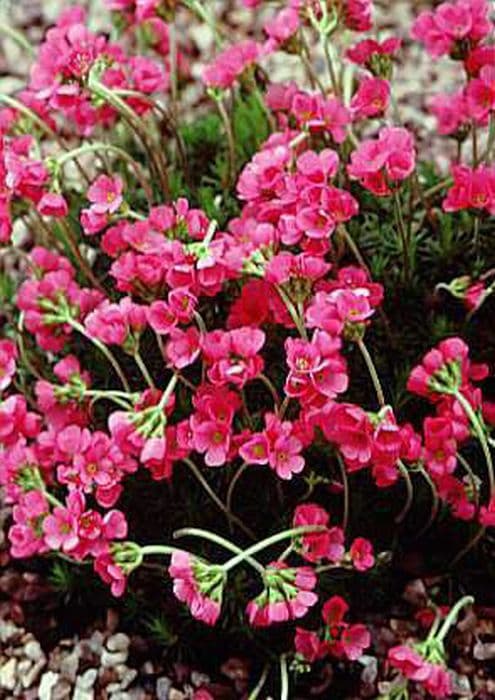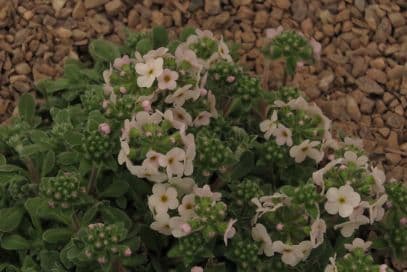Bog Pimpernel Anagallis tenella 'Studland'

ABOUT
The Anagallis tenella 'Studland', commonly known as the "Bog Pimpernel", features a delicate and enchanting appearance. Its foliage is comprised of small, ovate to lance-shaped leaves that exude a lush green hue, creating a plush carpet-like effect. During the flowering season, the Bog Pimpernel produces an abundance of tiny, vibrant pink flowers, each with a rounded shape and five distinct petals that often display a subtle range of pink shades, adding a touch of whimsy to its look. These charming blossoms are typically adorned with a darker pink or purplish central eye, which further accentuates the floral display. The overall form of the plant is low-growing, with a trailing habit that allows it to spread gracefully, contributing to its picturesque quality and making it an attractive ground cover or addition to rock gardens, where its striking flowers can create a sea of color. The Bog Pimpernel's delicate flowers and soft foliage combine to create an alluring visual texture, inviting closer inspection and offering a delightful display to any onlooker.
About this plant
 Names
NamesFamily
Primulaceae
Synonyms
Bog Pimpernel, Trailing Pimpernel
Common names
Anagallis linifolia, Anagallis tenella subsp. linifolia, Centunculus minimus.
 Toxicity
ToxicityTo humans
The common name for Anagallis tenella 'Studland' is Bog Pimpernel. This plant is considered to have toxic properties, although it is not commonly regarded as a highly poisonous plant. If ingested, the saponins present in the plant can cause gastrointestinal disturbances such as nausea, vomiting, and diarrhea. Ingestion of large quantities might lead to more severe symptoms, but generally, significant poisonings are rare because the plant's bitter taste tends to deter ingestion.
To pets
Bog Pimpernel can also be toxic to pets if ingested. Similar to its effects on humans, the plant contains saponins that can irritate the gastrointestinal tract, potentially leading to symptoms like vomiting, diarrhea, and abdominal pain. In most cases, pets are unlikely to consume large amounts because of the plant's bitter taste, but if they do, pet owners should consult a veterinarian.
 Characteristics
CharacteristicsLife cycle
Perennials
Foliage type
Evergreen
Color of leaves
Green
Flower color
Pink
Height
0.16 feet (5 cm)
Spread
0.5 feet (15 cm)
Plant type
Herb
Hardiness zones
8
Native area
Europe
Benefits
 General Benefits
General Benefits- Ornamental Appeal: Anagallis tenella, commonly known as the bog pimpernel, has delicate pink flowers, which can add a burst of color to garden beds, borders, and rockeries.
- Attracts Pollinators: Its blossoms are a source of nectar and attract bees and butterflies, aiding in the pollination of surrounding plants.
- Groundcover: This low-growing plant can form a dense mat, effectively acting as a groundcover to suppress weeds and help protect the soil from erosion.
- Easy to Grow: Bog pimpernel is known for being an undemanding plant, adaptable to different soil types, though it prefers moist conditions.
- Compact Size: Due to its small size, it's suitable for planting in small gardens, pots, or spaces where ground coverage is desired without overwhelming other plants.
 Medical Properties
Medical PropertiesThis plant is not used for medical purposes.
 Air-purifying Qualities
Air-purifying QualitiesThis plant is not specifically known for air purifying qualities.
 Other Uses
Other Uses- Photography Prop: Due to its bright and attractive flowers, the Bog Pimpernel can be utilized by photographers as a natural prop to enhance the visual appeal of outdoor photo shoots.
- Educational Resource: The Bog Pimpernel, with its unique growing requirements, serves as a specimen in ecology and botany education, helping students learn about wetland plant species and their habitats.
- Artistic Inspiration: Artists may use the Bog Pimpernel as a subject for painting and drawing, capturing its delicate structure and vibrant color.
- Garden Design: This plant can be used in garden designs that aim to recreate a miniature bog or damp meadow setting for aesthetic purposes.
- Fairy Gardens: Due to its small size and enchanting appearance, the Bog Pimpernel is suitable for creating fairy gardens where it contributes to a magical miniature landscape.
- Ecosystem Services: Planted in a suitable habitat, the Bog Pimpernel can contribute to local biodiversity and provide support for colonies of insects that rely on native flowering plants.
- Nature-Themed Crafts: Dried flowers and stems of the Bog Pimpernel can be used in crafting, such as in the creation of natural wreaths or as decorative elements in dried flower arrangements.
- Outdoor Learning Areas: The plant can be incorporated into outdoor learning areas for children, helping to foster an appreciation for nature and a hands-on learning environment.
- Water Features: In gardens with ponds or water features, the Bog Pimpernel can be planted at the edges, adding color and interest to the water's margin.
- Seasonal Displays: As a plant that flowers from June to August, the Bog Pimpernel can be included in seasonal floral displays that highlight summer blooms.
Interesting Facts
 Feng Shui
Feng ShuiThe Bog Pimpernel is not used in Feng Shui practice.
 Zodiac Sign Compitability
Zodiac Sign CompitabilityThe Bog Pimpernel is not used in astrology practice.
 Plant Symbolism
Plant Symbolism- Hope: Anagallis tenella, commonly known as the Bog Pimpernel, often symbolizes hope due to its ability to bloom in challenging environments, reminding us that even in difficult conditions there can be beauty and growth.
- Rediscovery: The Bog Pimpernel can also represent rediscovery or a return since it is a perennial plant that reemerges every year, signalling resilience and the concept of rebirth or coming back.
- Delicacy: With its delicate petals, the Bog Pimpernel can symbolize fragility and the need to handle situations with care and gentleness.
- Perseverance: Since this plant thrives in boggy conditions where other plants might not survive, it stands for perseverance and the idea of enduring through challenging times.
 Water
WaterBog Pimpernel should be watered regularly to keep the soil consistently moist but not waterlogged. It thrives in damp conditions, so during dry spells, you might need to water it every couple of days. The frequency of watering will also depend on the climate and the current weather conditions. If planted in a container, check the soil moisture by touching it and water when the top inch feels dry. Aim to provide approximately 1 gallon of water per square foot of soil every week under normal conditions. Adjust the amount of water during hotter, dryer periods or if you receive a significant amount of rainfall.
 Light
LightBog Pimpernel prefers partial shade to full sun, with dappled sunlight being ideal. It should be placed in a location where it will be protected from the harsh midday sun, which could scorch the delicate leaves. Morning sun with afternoon shade or a spot that receives filtered light throughout the day would provide the best lighting conditions for this plant.
 Temperature
TemperatureBog Pimpernel favors cool to moderate temperature conditions. It can typically withstand temperatures down to 20°F and up to about 80°F. The ideal temperature range would be between 50°F and 70°F. Excessive heat or cold could damage or potentially kill the plant, so it's essential to avoid extremes when choosing a location for Bog Pimpernel.
 Pruning
PruningBog Pimpernel benefits from occasional pruning to remove dead or yellowing foliage and encourage bushier growth. Prune in the early spring or after the plant has finished flowering to maintain its shape and health. Pruning can be done every year or every other year as needed to clean up the plant's appearance.
 Cleaning
CleaningAs needed
 Soil
SoilBog Pimpernel (Anagallis tenella 'Studland') thrives in moist, well-drained, humus-rich soil with a slightly acidic to neutral pH ranging from 5.5 to 7.0. To create an ideal soil mix, combine peat or coco coir, perlite, and garden loam in equal parts to ensure sufficient moisture retention and drainage.
 Repotting
RepottingBog Pimpernel should be repotted every 2 to 3 years to refresh the soil and encourage healthy growth. It's best to repot in the spring before the growing season commences, being careful not to damage the delicate root system.
 Humidity & Misting
Humidity & MistingBog Pimpernel prefers high humidity levels to mimic its native boggy habitats. Aim for humidity levels between 75% to 85%, which are conducive to the plant's health and vibrant growth without the need for additional water on the leaves.
 Suitable locations
Suitable locationsIndoor
Place in a bright spot with high humidity.
Outdoor
Partial shade, moist soil, protect from hot sun.
Hardiness zone
8-10 USDA
 Life cycle
Life cycleAnagallis tenella 'Studland', commonly known as the bog pimpernel, begins its life cycle as a seed, which upon finding favorable moist conditions, germinates in spring. It then develops into a small seedling, establishing a root system and sending up shoots. The plant grows and produces a rosette of leaves, and stems that may root at the nodes. In summer, it enters its flowering stage, producing delicate small pink flowers that are pollinated by insects. Following pollination, the flowers develop into small seed capsules containing numerous seeds. As temperatures drop in autumn, the bog pimpernel completes its annual life cycle by setting seeds before dying back, while some plants may survive mild winters to grow again the next season.
 Propogation
PropogationPropogation time
Spring-Early Summer
Propogation: Anagallis tenella 'Studland', commonly known as the pimpernel, is often propagated through seed sowing or division, with the most popular method being division. This is typically done in spring or early summer when the plant is actively growing. To propagate by division, carefully dig up the plant and gently separate the rootball into smaller sections, making sure each new section has a part of the root system and several shoots. These sections can then be immediately replanted in similar growing conditions to the parent plant. This method is favored for its simplicity and effectiveness in quickly multiplying the number of plants.









